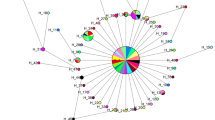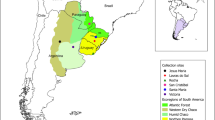Abstract
To test the hypothesis of the migration of the corn borer, the allozymes of nine populations of the corn borer(Ostrinia) in China were checked using verticalslab polyacrylamide gel electrophoresis. Eight loci of six allozymes were analyzed. The mean of the genetic identities among the nine populations calculated from the allele frequencies was 0.99068, much closer than that of other species and geographical populations. The mean (0.97955) of the genetic identities between the XJYN population (Ostrinia nubilalis Hübner, collected from Yining, Xinjiang Autonomous Region) and each of the other eight populations (O. furnacalis Guenée) was significantly smaller than that between the pairs of the eight populations (0.99386;t test,P<0.01). Although the population XJYN clearly deviates from the other eight populations in the dendrogram, the relationship of the two species of corn borer was very close. It is possible that the speciation of corn borer may have resulted from single-gene substitutions.
Similar content being viewed by others
References
All China Corn Borer Research Group (1988). Studies on the identification of the dominant corn borer species in China.Acta Phytophyl. Sinica 15(3):145.
Ayala, F. J. (1975). Genetic differentiation during the speciation process. InEvol. Biol. Vol. 8 Plenum Press, New York, pp. 1–78.
Ayala, F. J.,et al. (1972). Enzyme variability in theDrosophila willistoni group IV. Genetic variation in natural populations ofDrosophila willistoni.Genetics 70113.
Editorial Committee of the Plant Diseases and Insect Pests on Crops in China (1979).The Plant Diseases and Insect Pests on Crops in China (I) Agr. Press, Beijing.
Ferguson, A. (1980).Biochemical Systematics and Evolution John Wiley and Sons, New York.
Harrison, R. G., and Vawter, A. T. (1977). Allozyme differentiation between pheromone strains of the European corn borer,Ostrinia nubilalis.Ann. Entomol. Soc. Am. 70717.
Mutuura, A., and Munroe, E. (1970). Taxonomy and distribution of the European corn borer and allied species: GenusOstrinia. Memoirs of Entomological Society of Canada. No. 71.
Nei, M. (1972). Genetic distance between populations.Am. Nat. 106283.
Richardson, B. J.,et al. (1986).Allozyme Electrophoresis: A Handbook for Animal Systematics and Population Studies Academic Press, New York.
Sneath, P. H. A., and Sokal, R. R. (1973).Principles of Numerical Taxonomy Freeman, San Francisco.
Terranova, A. C. (1981). Polyacrylamide gel electrophoresis ofAnthonomus grandis Boheman proteins, UDSA, SEA, Agr. Res. Results ARB-S-9.
Wang, Y. M. (1983). The discussion to the long distance migration of corn borer.Entomol. Knowledge. (China) 20(t):195.
Wang, Z. Y.,et al. (1994). Studies on behaviour of dispersal and possibility of migration in adult overwintering generation Asian corn borer by using release- and recapture technique.Acta Phytophyl. Sinica (China) 21(1):25–31.
Zhai, B. P., and Chen, R. L. (1989). Flight capacity of Asian corn borer (Ostrinia furnacalis Guenée).Agr. Sci. Jilin (China) 140.
Zhao, C., and Wang, X. (1990). Sex pheromone biosynthesis in Asian corn borerOstrinia furnacalis. Sex pheromone biosynthetic precursors.Chinese Sci. Bull. 35(9):767.
Zhao, C., Löfstedt, C., and Wang, X. (1990). Sex pheromone biosynthesis in Asian corn borerOstrinia furnacalis (II). Biosynthesis of E- and Z-12-tetradecenyl acetate involves 14 desaturation.Arch. Insect Biochem. Phys. 1557.
Author information
Authors and Affiliations
Rights and permissions
About this article
Cite this article
Wang, R., Yan, F., Li, S. et al. Allozyme differentiation among nine populations of the corn borer (Ostrinia) in China. Biochem Genet 33, 413–420 (1995). https://doi.org/10.1007/BF00554599
Received:
Revised:
Issue Date:
DOI: https://doi.org/10.1007/BF00554599




